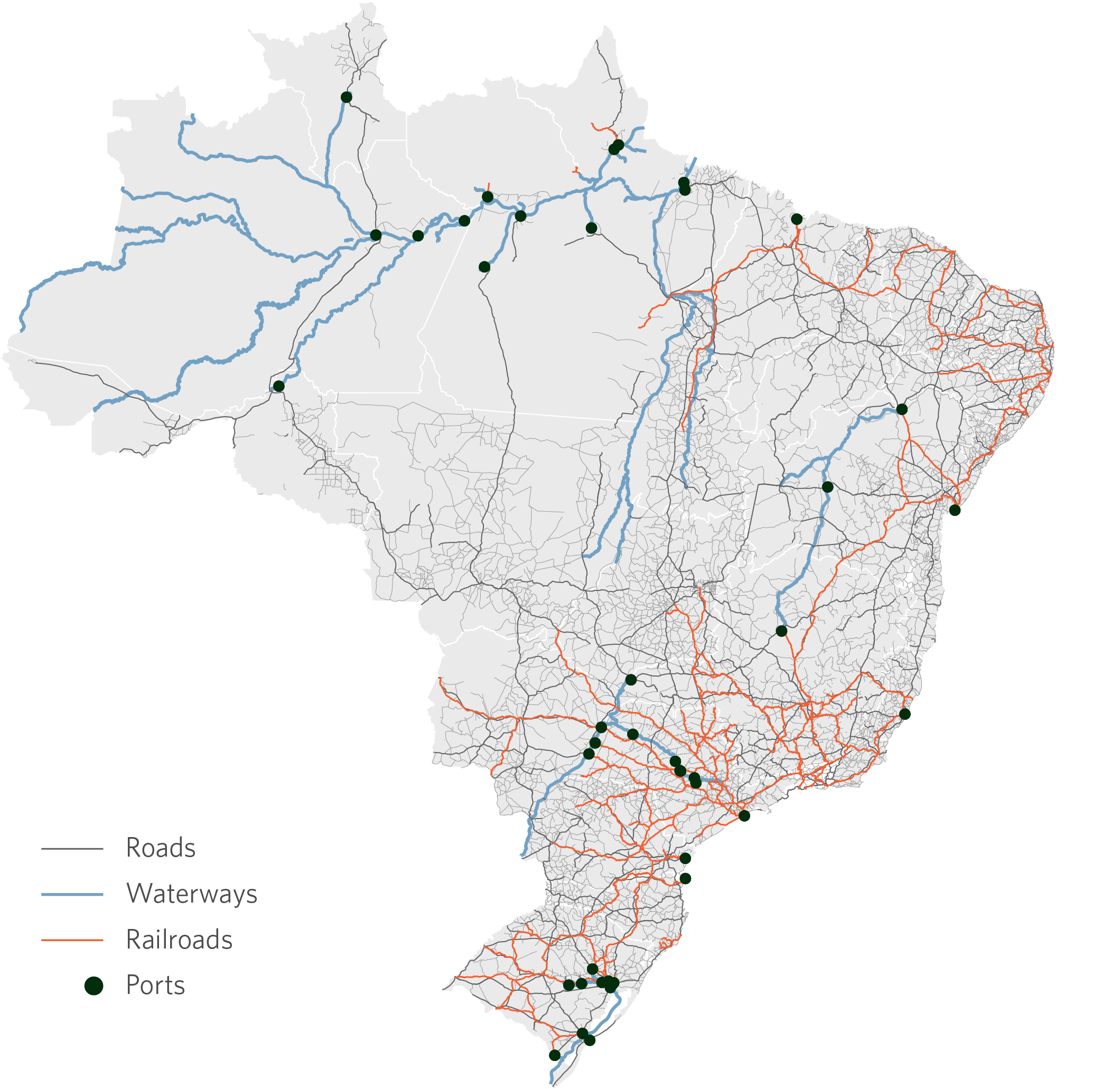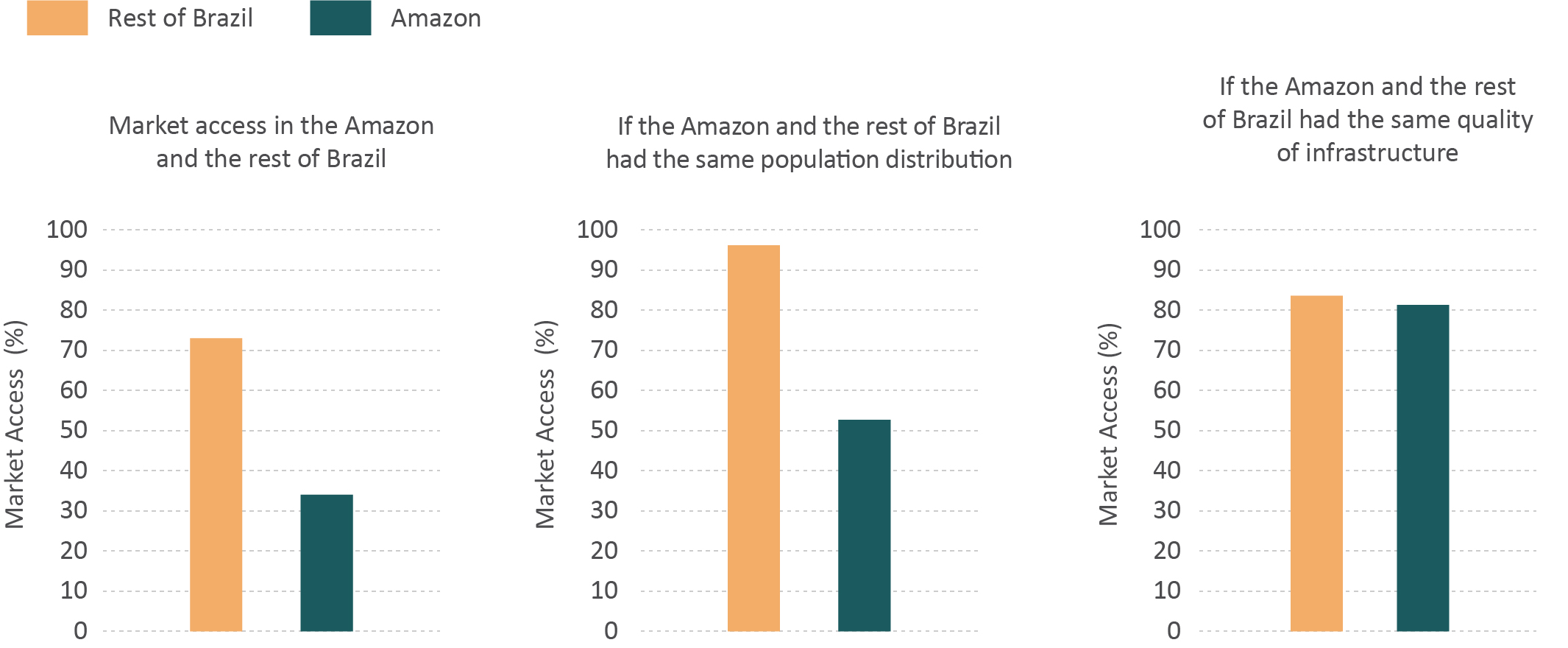An excellent transportation infrastructure is essential for promoting regional development. Areas served by efficient networks of waterways, railways and roads are well-equipped to do business with other regions. This ends up increasing local competitiveness and influencing businesses and individuals to establish themselves in the region. The increase in the number of businesses and workers, in turn, leads to economies of scale, further strengthening the region’s competitiveness and attracting even more businesses and workers.[1],[2],[3],[4],[5],[6],[7]
Improving accessibility is a key strategic component in remote and sparsely populated areas such as the Legal Amazon. To improve a region’s accessibility, one challenge is to identify – among the various existing logistical infrastructure investment possibilities – the best investment opportunities to increase the region’s accessibility. This requires appropriate accessibility metrics that summarize how different investments influence a region’s accessibility.
Building these metrics, however, is conceptually complex, since any region has numerous relevant transportation costs, and each one of them influences regional economies in different ways. For example, the set of transportation costs relevant to the competitiveness of a producer who imports materials from outside the region and produces for the local market will be completely different from the transportation costs relevant to a producer who imports materials from one location and exports its product to another part of the country.
This report presents groundbreaking estimates of the accessibility of the municipalities in the Legal Amazon. It first discusses how it is possible to summarize the effects of the transportation cost structure on a regional economy in a single metric called market access. It then presents the data and procedures used to construct the market access metric for Brazilian municipalities. Next, it discusses how the accessibility of the municipalities in the Legal Amazon compares to the accessibility of the municipalities in other parts of the country. Finally, it breaks down the accessibility metrics into different components to show that the poor quality of the transportation network is the key factor in the greater isolation of the municipalities in the Legal Amazon compared to the other municipalities in Brazil.
Market Access: Definition and Measurement
One challenge in measuring the accessibility of different regions is that there are numerous mechanisms by which the transportation cost structure influences a regional economy. Changes in transportation costs have differing effects on businesses that export their products to other regions, businesses that compete with imported products, and businesses that sell services. These changes also exert differing influences on workers with different levels of education and employees working in different economic sectors. In addition, the changes in relevant transportation costs for various businesses and workers can be fundamentally different. For example, for some companies the relevant transportation costs could involve getting to the regions where they buy their materials, while for others the relevant transportation costs could involve getting to the regions where they sell their finished product.
During the past decade, the international business literature developed a methodology that allows all these effects to be summed up in a single accessibility metric called market access. The literature shows that this metric captures the balancing effects of transportation costs on the choices made by consumers and producers in a comprehensive category of models of inter-regional commerce.
In general, the market access of a region is calculated as the weighted average of the market size of its business partners (domestic and international) and the transportation costs between the region and its business partners. This measurement can be interpreted as the potential market of a region — it uses transportation costs to express the population of distant markets in the same unit of population as nearby markets.
To construct market access, four types of information must be collected:
- The population of each municipality in the country;
- The relative sizes of the international market and the domestic market;
- Transportation costs between the country’s municipalities; and,
- Transportation costs between the country’s municipalities and the international market.
The sizes of domestic and international markets can be obtained directly from public data. But the measurements of transportation costs between municipalities as well as between the municipalities and the international market must be constructed from freight data and transportation network data.
Three steps are involved in constructing these measurements. First, a georeferenced information base is created. This includes information about federal and state roads, railways, railway stations, navigable rivers, and inland ports (Figure 1). Next, data on road freight, regulatory information on rail and waterway freight, and statistical models are used to estimate the various travel costs for each mode of transport that exists in the country. Finally, an algorithm is developed using information from the transportation network and from the costs of the various modes of transportation to produce an estimate of the optimal routes and transportation costs between each pair of municipalities in Brazil and between each municipality and the country’s biggest ports. This exercise involves making estimates of a total of 15.5 million optimal routes and transportation costs.
Figure 1. Network of Transports in Brazil

Source: CPI/PUC-Rio with data from Ministry of Infrastructure, 2022
Findings
The market access of a typical municipality in the Legal Amazon is around 2.1 times lower than the market access of a typical municipality in the rest of the country (Figure 2). The spatial distribution of market access in the Legal Amazon indicates that the municipalities located in closer proximity to other parts of the country have much greater market access than municipalities located in the interior of the Legal Amazon. The exception to this rule is the municipalities located between Belém, Santarém, and Manaus, which benefit greatly from the region’s excellent waterway infrastructure.
Figure 2. Market Access in Brazil and Legal Amazon

Note: The city of São Paulo has market access normalized to 1.
Source: CPI/PUC-Rio with data from Ministry of Infrastructure, Demographic Census (IBGE), and SIFRECA/ESALq, 2022
The differences in market access observed between municipalities located inside and outside the Legal Amazon may reflect differences in population distribution and transportation costs in different parts of the country. One possibility is that the regional differences in market access are primarily a result of the lower demographic density of the Legal Amazon compared to the rest of the country. This lower demographic density suggests that the area surrounding a typical municipality in the Legal Amazon is less populated than a typical municipality in the rest of the country, and this reduces its market access. To examine whether this is an important factor in regional accessibility differences, researchers test how these differences change when each municipality is presumed to have the same population, thereby completely eliminating the influence of population distribution on market access. The market access of a typical municipality in the Legal Amazon is still 1.8 times lower than the market access of a typical municipality in the rest of the country when differences in population distribution are eliminated.
Figure 3. Average of Market Access by Region and Scenario

Source: CPI/PUC-Rio with data from Ministry of Infrastructure, Demographic Census (IBGE), and SIFRECA/ESALq, 2022
These findings suggest that differences in transportation costs are the primary factor in the isolation of the Legal Amazon. Yet these differences might also result from the fact that the region’s municipalities are further apart or that they have weaker transportation infrastructure. To differentiate between these explanations, researchers test how regional differences in accessibility change when transportation costs between municipalities are presumed to be directly proportional to distance, thereby completely eliminating the influence of infrastructure quality on market access. The difference in market access between municipalities in the Legal Amazon and other regions drops dramatically when differences in infrastructure quality are eliminated. In this scenario, the market access of a typical municipality in the Legal Amazon is very similar to the market access of a typical municipality in the rest of the country (Figure 3).
Conclusion
This report presents groundbreaking estimates of the accessibility of the municipalities in the Legal Amazon. Using a market access approach applied to Brazilian municipalities, developed by researchers at Climate Policy Initiative/Pontifical Catholic University of Rio de Janeiro (CPI/PUC-Rio), it shows that the potential market of a typical municipality in the Legal Amazon is 2.1 times lower than the potential market of a typical municipality in the rest of the country. By examining the measurement of market access, the report shows that most of the regional disparities in accessibility can be explained by differences in infrastructure quality (and not in population distribution or average distance between municipalities). Next up in this series of texts, “Accessibility in the Legal Amazon: Delimiting the Area of Influence and Environmental Risks” discusses the difficulties and costs associated with expanding logistical infrastructure in the Amazon and recommends ways to improve project viability.
[1] Fujita, Masahisa, Paul R. Krugman, and Anthony Venables. The spatial economy: Cities, regions, and international trade. MIT press, 1999.
[2] Redding, Stephen and Anthony J. Venables. “Economic geography and international inequality”. Journal of International Economics 62, no. 1 (2004): 53-82.
[3] Redding, Stephen, and Daniel M. Sturm. “The costs of remoteness: Evidence from German division and reunification”. American Economic Review 98, no. 5 (2008): 1766-1797.
[4] Donaldson, Dave, and Richard Hornbeck. “Railroads and American economic growth: A ‘market access’ approach”. The Quarterly Journal of Economics 131, no. 2 (2016): 799-858.
[5] Donaldson, Dave. “Railroads of the Raj: Estimating the impact of transportation infrastructure”. American Economic Review 108, no. 4-5 (2018): 899-934.
[6] Storeygard, Adam. “Farther on down the road: transport costs, trade and urban growth in sub-Saharan Africa”. The Review of Economic Studies 83, no. 3 (2016): 1263-1295.
[7] Jedwab, Remi and Adam Storeygard. “The average and heterogeneous effects of transportation investments: Evidence from Sub-Saharan Africa 1960-2010”. Journal of the European Economic Association 20, no. 1 (2022): 1-38.

